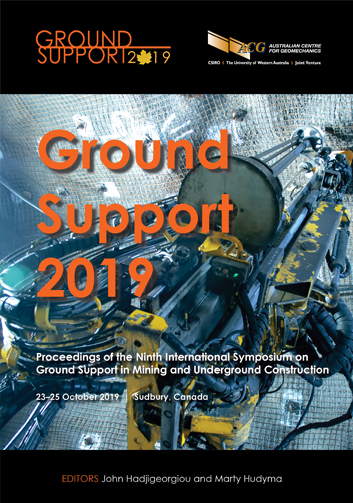Microbiologically induced cable bolt corrosion in underground coal mines

|
Authors: Chen, H; Kimyon, O; Ramandi, HL; Hebblewhite, B; Manefield, M; Crosky, A; Saydam, S; Kaksonen, AH; Morris, C |
DOI https://doi.org/10.36487/ACG_rep/1925_30_Chen
Cite As:
Chen, H, Kimyon, O, Ramandi, HL, Hebblewhite, B, Manefield, M, Crosky, A, Saydam, S, Kaksonen, AH & Morris, C 2019, 'Microbiologically induced cable bolt corrosion in underground coal mines', in J Hadjigeorgiou & M Hudyma (eds), Ground Support 2019: Proceedings of the Ninth International Symposium on Ground Support in Mining and Underground Construction, Australian Centre for Geomechanics, Perth, pp. 437-442, https://doi.org/10.36487/ACG_rep/1925_30_Chen
Abstract:
Corrosion failure is one of the serious concerns with most metal products. In the mining industry, corrosion failure of cable bolts may threaten the safety of operations and cause significant financial losses. In recent years, many cable bolt failures have been reported from several underground coal mines in Australia. Recent studies have shown that the localised environment around the cable bolts (oxygen level, groundwater, bacteria, etc.) has a significant impact on the corrosion behaviour; however, studies on the role of bacteria in the corrosion of underground support systems are still limited. This paper reports on a study of the role of a well-known bacterium in microbiologically induced corrosion of cable bolts. Acidithiobacillus ferrooxidans is found in many underground mines. The cable bolt specimens used in the study were specially designed to simulate the stress level experienced in the in situ mine condition. The specimens were analysed based on their weight loss and morphological features at the end of the study. The results indicated that the involvement of the bacteria in localised corrosion development and biofilm formation on the metal surface was a contributing factor in accelerating the corrosion of the bolt and could lead to catastrophic failure of the bolts in the long term.
Keywords: Acidithiobacillus ferrooxidans, cable bolt, corrosion failure, underground mine, safety
References:
Flemming, H-C & Shaule, G 1994, ‘Microbial deterioration of materials – biofilm and biofouling: Biofouling (Mikrobielle Werkstoffzerstö rung e Biofilm und Biofouling: biofouling), Materials and Corrosion, vol. 45, January, pp. 29–39.
Kelly, DP & Wood, AP 2000, ‘Reclassification of some species of Thiobacillus to the newly designated genera Acidithiobacillus gen. nov., Halothiobacillus gen. nov. and Thermithiobacillus gen. nov’, International Journal of Systematic and Evolutionary Microbiology, vol. 50, pp. 511–516.
Little, BJ, Mansfeld, FB, Arps, PJ & Earthman, JC 2007, ‘Microbiologically Influenced Corrosion’, Encyclopedia of Electrochemistry, Wiley Online Library.
Moradi, M, Duan, J, Ashassi-Sorkhabi, H & Luan, X 2011, ‘De-alloying of 316 stainless steel in the presence of a mixture of
metal-oxidizing bacteria’, Corrosion Science, vol. 53, pp. 4282–4290.
Rojas-Chapana, J & Tributsch, H 2001, ‘Biochemistry of sulfur extraction in bio-corrosion of pyrite by Thiobacillus ferrooxidans’ Hydrometallurgy, vol. 59, pp. 291–300.
Suzuki, I, Takeuchi, TL, Yuthasastrakosol, TD & Oh, JK 1990, ‘Ferrous iron and sulfur oxidation and ferric iron reduction activities of Thiobacillus ferrooxidans are affected by growth on ferrous iron, sulfur, or a sulfide ore’, Applied and Environmental Microbiology, vol. 56, pp. 1620–1626.
Temple, KL & Colmer, AR 1951, ‘The autotrophic oxidation of iron by a new bacterium: Thiobacillus ferrooxidans’, Journal of Bacteriology, vol. 62, p. 605.
Videla, HA 2001, ‘Microbially induced corrosion: An updated overview’, International Biodeterioration & Biodegradation, vol. 48, pp. 176–201.
Wang, H, Ju, L-K, Castaneda, H, Cheng, G & Newby, B-MZ 2014, ‘Corrosion of carbon steel C1010 in the presence of iron oxidizing bacteria Acidithiobacillus ferrooxidans’, Corrosion Science, vol. 89, pp. 250–257.
Wu, S Chen, H, Craig, P, Ramandi, HL, Timms, W, Hagan, PC, … & Saydam, S 2018, ‘An experimental framework for simulating stress corrosion cracking in cable bolts’, Tunnelling and Underground Space Technology, vol. 76, pp. 121–132.
© Copyright 2025, Australian Centre for Geomechanics (ACG), The University of Western Australia. All rights reserved.
View copyright/legal information
Please direct any queries or error reports to repository-acg@uwa.edu.au
View copyright/legal information
Please direct any queries or error reports to repository-acg@uwa.edu.au